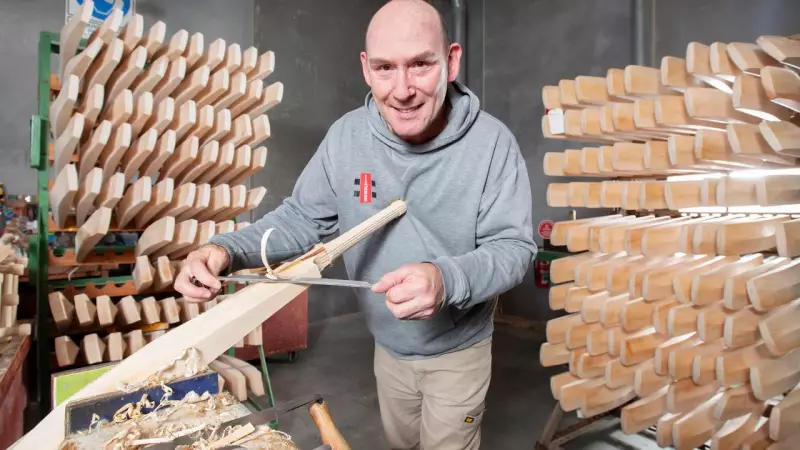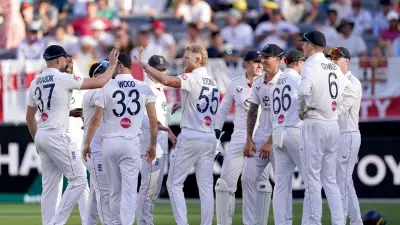
When Australia's cricket stars touch down in Melbourne, there's one essential destination that consistently draws them away from the hallowed turf of the MCG. Just thirty minutes south in the bayside suburb of Cheltenham lies what many consider cricket's hidden sanctuary – the legendary Gray Nicolls bat mill.
The Heart of Australian Bat Making
Since establishing its Australian operations in 1972, this workshop has become the birthplace of iconic cricket bats that have shaped the game. From the revolutionary Scoop to the powerful Kaboom designs, and exclusive collector items valued up to $2500, this facility represents cricket craftsmanship at its finest.
Heading this operation is master bat-maker Stuart Kranzbuhler, who has dedicated 32 years to perfecting his craft. During his tenure, he's personally served cricket royalty including Shane Warne, Travis Head, David Warner, David Boon, Matthew Hayden, Andrew Symonds, and Mitch Marsh.
"All the players visit us when they're in Melbourne – they make a point of coming in for a chat," Kranzbuhler reveals. "Some try their hand at bat-making, but many get nervous about potentially ruining a perfect piece of willow. What they truly appreciate is the consistency our bats offer. They know they can pick one up and start using it immediately – that's the advantage of local Melbourne manufacturing."
Craftsmanship Meets Modern Demand
While Gray Nicolls celebrated 50 years of Australian production in 2022, the company's bat-making heritage stretches back to 1875 in the United Kingdom. The Australian division specifically caters to mid and top-tier markets in Australia and New Zealand, with all products proudly displaying the Australian Made logo.
The workshop's small but highly skilled team of five bat makers and three detailers produces an impressive 6000 bats annually. They source premium willow exclusively from the company's own UK plantations.
Each bat undergoes a meticulous creation process that blends modern technology with traditional handcrafting techniques. The complete transformation from raw willow to finished product takes just two to three hours, involving precise pressing, shaping, sanding, and finishing stages.
Kranzbuhler, the creator of Warner's famous Kaboom bat, notes significant evolution in bat-making standards since his early days. "The process has changed dramatically. When I started, we relied more heavily on machines, which actually made the work easier. Players weren't as concerned about specific weights – they wanted bats that were generally light. Today, every gram counts and specifications are exact."
Adapting to Cricket's Changing Landscape
The explosion of T20 cricket has fundamentally changed equipment demands. Bats now endure far greater punishment than in previous eras.
"When I began my career, David Boon might need only two or three bats per year," Kranzbuhler observes. "Contemporary players can use up to fifteen bats annually. T20 cricket represents the most brutal form on equipment – the power hitting places incredible stress on the bats."
Gray Nicolls provides crucial support services for Australian and New Zealand international teams, offering a rapid seven-day turnaround for repairs or replacements. "We take great pride in our service and what we offer the cricket community," Kranzbuhler emphasizes. "This level of responsiveness simply isn't available from outsourced or overseas brands."
Despite increasing competition from India's internationally recognized bat-making industry, Gray Nicolls maintains its reputation for superior craftsmanship. "We actually intensified our hand-making processes as India improved their techniques," Kranzbuhler explains. "This ensures we achieve the optimal shape and feel. We've invested significantly in pressing technology to maintain our market leadership."
Future Challenges and Commitment
The company faces emerging challenges, including climate change concerns affecting the cool weather conditions willow trees require. However, the most immediate obstacle involves finding new generations of skilled craftspeople.
"Fewer young people are entering manual trades today," Kranzbuhler notes. "Many seek quicker paths to higher earnings. Successful bat makers need an eye for detail, excellent hand skills, understanding of both the game and timber properties. Some never grasp the necessary techniques, which is disappointing. But when we discover someone with all these qualities – it's absolutely terrific."
Despite these challenges, Kranzbuhler confirms the company remains committed to its core mission that has defined it for over half a century: preserving the tradition of Australian-made cricket bats and ensuring they continue to serve both professional stars and community players across the nation.





